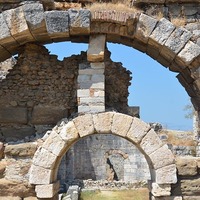Christof Berns
University of Hamburg, Archäologisches Institut, Faculty Member
- Hellenistic and Roman Asia Minor, Classical Archaeology, Roman Spain, European travellers and their depictions of the ancient and Islamic history of the Near East, Archaeology of Ritual, Roman Architecture, and 8 moreAnatolian Studies, Greek and Roman Tombs, Miletos, Greek and Roman Art and Architecture, Anatolian Archaeology, Ancient economy, Ancient economies (Archaeology), and Burial Practices (Archaeology)edit
Research Interests:
Writing is an essential cultural technique, and the resulting artefacts are an important part of cultural heritage. The Cluster of Excellence ‘Understanding Written Artefacts’ is an interdisciplinary and cross-cultural long-term project... more
Writing is an essential cultural technique, and the resulting artefacts are an important part of cultural heritage. The Cluster of Excellence ‘Understanding Written Artefacts’ is an interdisciplinary and cross-cultural long-term project dedicated to studying so-called ‘written artefacts (WA)’. Our work introduces immersive technologies such as virtual, augmented, and mixed reality to the research cluster for the first time. In this paper, we outline the scope of our research project and present our current implementations of immersive applications based on two scenarios involving inscribed spaces. So far, immersive technologies have not been used in academia to create research focused applications for exploring, analysing, and understanding WA within their inscribed space, including providing access to appropriate spatial and temporal contexts. Thus, we collaborate closely with researchers from the humanities to create interactive and immersive applications for the novel field of WA...
Research Interests:
Research Interests:
Research Interests:
Research Interests:
Research Interests:
This paper first chronicles five more years of work at Miletus and then presents the following new, as yet unpublished findings: An excavation in front of the theatre cave has unearthed the foundations of a significant building that... more
This paper first chronicles five more years of work at Miletus and then presents the following new, as yet unpublished findings: An excavation in front of the theatre cave has unearthed the foundations of a significant building that probably dates from the Hellenistic period, as well as several Byzantine ruins (A. Vacek). Investigation of the Byzantine city walls from the Invasion period has led to the discovery of a minor gate, probably a sally port (S. Giese). On Humeitepe, a small Turkish mosque or so-called mescit has been discovered (Ph. Niewöhner). A survey on Humeitepe confirms the ancient settlement history of this urban area through the analysis of small finds (Ch. Berns – S. Huy). New palynological findings improve our understanding of the Byzantine settlement history in the vicinity and the hinterland of the city (A. Izdebski). In addition, the paper also reports extensive site management and conservation work. The former includes new visitor paths, display panels, and gu...
Research Interests: Late Antique Archaeology, Palynology, Byzantine Archaeology, Turkish Art (Archaeology), Late Antique Art and Archaeology, and 11 moreArchaeological Conservation, Hellenistic and Roman Asia Minor, Archaeological survey, Archaeology of the Hellenistic East, Byzantine Art and Archaeolgy, Late Roman and early Byzantine fortifications, Asia Minor, Hellenistic architecture, Byzantine fortifications, Anadolu Beylikleri, and Byzantine history and archaeology
Research Interests:
Research Interests:
Research Interests:
This article presents a body of architectural reliefs and two stelae from the ancient town of Cibyra in the Roman province of Asia and, in most cases, now kept in the provincial Burdur Museum. The pieces show different aspects of... more
This article presents a body of architectural reliefs and two stelae from the ancient town of Cibyra in the Roman province of Asia and, in most cases, now kept in the provincial Burdur Museum. The pieces show different aspects of gladiatorial games, such as duels between gladiators and the hunting of animals. It is argued that the architectural reliefs once belonged to three different monumental tombs of munerarii, commemorating specific games sponsored by them, while the stelae were set up for single gladiators after their deaths. An analysis of the style of their execution indicates that the reliefs were produced in the second half of the second century AD. The iconography and composition of the gladiatorial combats depicted on these reliefs seem to have been influenced by a specific Hellenic view of the games, while the venatio scenes emphasise the richness of the show. In total, the material may contribute to a better understanding of the reception and transformation of the mune...
